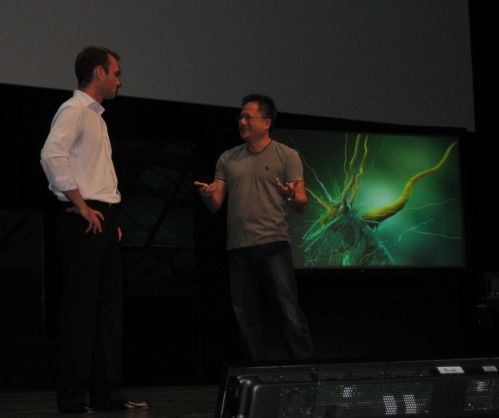We had a chance to ask Jen Hsun Huang, CEO of Nvidia, a few questions and we decided to post you his thoughts in two parts. Jensen and his Director of PR, Derek Perez, helped us out to get some answers on some hot topics.
1. What is the future of graphics and how is NVIDIA helping to bring this future about?
Jensen: “Just graphics” is not enough anymore. We are in the business of enhancing your visual experience. We continue to drive real-time graphics like our recent demonstration of the world’s first real-time ray tracer. But we are also making the GPU totally general purpose. We are making the GPU a great processor for image processing, video processing, parallel computing, just to name a few. We call this “Graphics Plus”. At the core of the “graphics plus” strategy is CUDA. CUDA is our general purpose parallel computing architecture; think of it as NVIDIA’s version of SSE, but for many-core parallel computing.
2. What does NVIDIA want to accomplish with CUDA technology?
Jensen: The PC is at a crossroads. There are diminishing returns with today’s processors. Dave Patterson and his Berkeley team correctly describe it as “the brick wall.” The paper is really worth reading and you can find it here.
CUDA was created to break from these “walls” with a new approach based on heterogeneous many-core processing. CUDA is the foundation of our parallel computing strategy. CUDA has seen tremendous reception around the world’s research community. Scientists are seeing a 20-200x speed-up with CUDA than over a CPU alone. CUDA is being taught in nearly 50 universities around the world now. It is being built into supercomputers and workstations. And since CUDA is standard in all of our modern GPUs, there are now nearly 100 million PCs in the world capable of running CUDA-based applications. We are now at a tipping point. Many consumer application companies are now developing CUDA applications that were simply not possible before.
3. Is there enough space for NVIDIA chipsets on the market, especially for Intel?
Jensen: We will build chipsets for market segments that are growing and those that value a great visual experience. Take for example, the consumer notebook market, which foresees major growth year over year. In a market like this, we have a huge advantage in being able to develop innovative platforms that help drive visual computing to new heights. From a graphics perspective alone, we are years ahead of the competition; but we have the ability to introduce additional technologies, such as SLI and Hybrid SLI that focuses on the visual experience and can be unique to our platforms.

More tomorrow.

